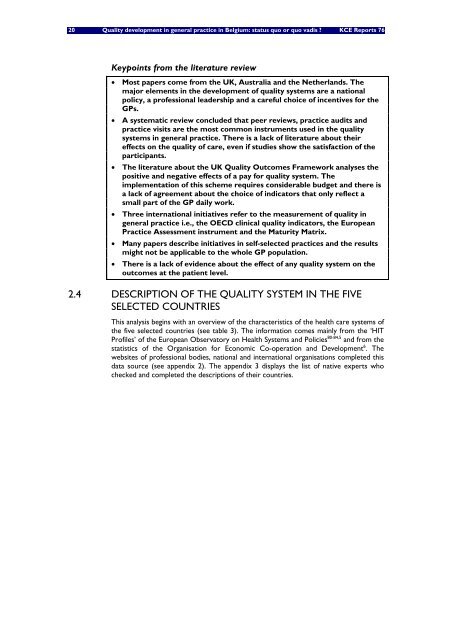status quo of quo vadis? - KCE
status quo of quo vadis? - KCE
status quo of quo vadis? - KCE
You also want an ePaper? Increase the reach of your titles
YUMPU automatically turns print PDFs into web optimized ePapers that Google loves.
20 Quality development in general practice in Belgium: <strong>status</strong> <strong>quo</strong> or <strong>quo</strong> <strong>vadis</strong> ? <strong>KCE</strong> Reports 76<br />
Keypoints from the literature review<br />
• Most papers come from the UK, Australia and the Netherlands. The<br />
major elements in the development <strong>of</strong> quality systems are a national<br />
policy, a pr<strong>of</strong>essional leadership and a careful choice <strong>of</strong> incentives for the<br />
GPs.<br />
• A systematic review concluded that peer reviews, practice audits and<br />
practice visits are the most common instruments used in the quality<br />
systems in general practice. There is a lack <strong>of</strong> literature about their<br />
effects on the quality <strong>of</strong> care, even if studies show the satisfaction <strong>of</strong> the<br />
participants.<br />
• The literature about the UK Quality Outcomes Framework analyses the<br />
positive and negative effects <strong>of</strong> a pay for quality system. The<br />
implementation <strong>of</strong> this scheme requires considerable budget and there is<br />
a lack <strong>of</strong> agreement about the choice <strong>of</strong> indicators that only reflect a<br />
small part <strong>of</strong> the GP daily work.<br />
• Three international initiatives refer to the measurement <strong>of</strong> quality in<br />
general practice i.e., the OECD clinical quality indicators, the European<br />
Practice Assessment instrument and the Maturity Matrix.<br />
• Many papers describe initiatives in self-selected practices and the results<br />
might not be applicable to the whole GP population.<br />
• There is a lack <strong>of</strong> evidence about the effect <strong>of</strong> any quality system on the<br />
outcomes at the patient level.<br />
2.4 DESCRIPTION OF THE QUALITY SYSTEM IN THE FIVE<br />
SELECTED COUNTRIES<br />
This analysis begins with an overview <strong>of</strong> the characteristics <strong>of</strong> the health care systems <strong>of</strong><br />
the five selected countries (see table 3). The information comes mainly from the ‘HIT<br />
Pr<strong>of</strong>iles’ <strong>of</strong> the European Observatory on Health Systems and Policies 80-84,5 and from the<br />
statistics <strong>of</strong> the Organisation for Economic Co-operation and Development 6 . The<br />
websites <strong>of</strong> pr<strong>of</strong>essional bodies, national and international organisations completed this<br />
data source (see appendix 2). The appendix 3 displays the list <strong>of</strong> native experts who<br />
checked and completed the descriptions <strong>of</strong> their countries.

















